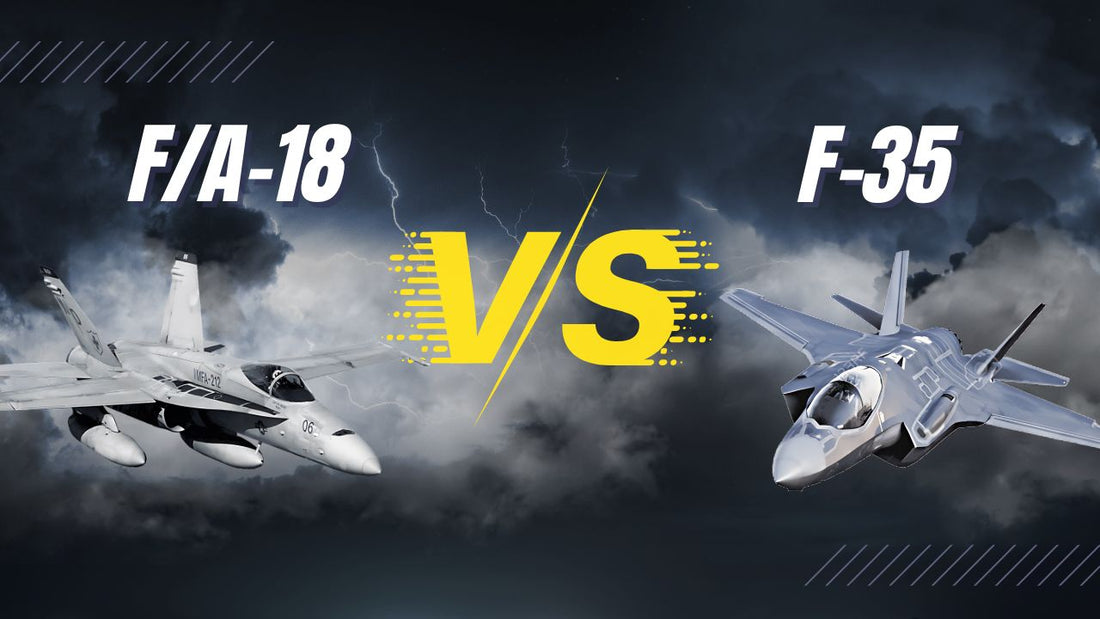
F-35 vs. F/A-18: The Navy's Two Most Iconic Planes
Share
In modern naval aviation, few platforms capture as much attention as the F-35C Lightning II and the F/A-18E/F Super Hornet. These two aircraft represent distinct generations of U.S. Navy air power: one is a fifth-generation stealth fighter built for tomorrow’s battlespace, while the other is a combat-proven multirole workhorse that has served with distinction for decades.
This article offers a detailed comparison of these two platforms, evaluating their performance, capabilities, roles, and future relevance within the U.S. Navy’s carrier strike groups.
Aircraft Overview
F-35C Lightning II
-
Manufacturer: Lockheed Martin
-
Role: Stealth multirole strike fighter
-
Generation: Fifth
-
First Flight: 2010
-
Carrier Variant: Features larger wings, tailhook, and reinforced landing gear
The F-35C is the Navy’s first stealth aircraft designed for catapult launches and arrested landings. It offers unparalleled situational awareness, data fusion, and survivability in highly contested environments.
F/A-18E/F Super Hornet
-
Manufacturer: Boeing
-
Role: Carrier-capable multirole fighter
-
Generation: Fourth+
-
First Flight: 1995
-
Variants: E (single-seat), F (two-seat)
The Super Hornet is a larger, more advanced evolution of the legacy F/A-18 Hornet. It has proven itself in multiple conflicts and remains the backbone of the U.S. Navy’s carrier air wings.
Performance and Specifications
| Specification | F-35C Lightning II | F/A-18E/F Super Hornet |
|---|---|---|
| Max Speed | Mach 1.6 | Mach 1.6 |
| Engine Thrust | 43,000 lbf (single engine) | 2 × 22,000 lbf (twin engines) |
| Combat Radius | ~670 nautical miles | ~390 nautical miles |
| Service Ceiling | 50,000 ft | 50,000 ft |
| Weapons Load | ~18,000 lbs (internal + external) | ~17,750 lbs (external) |
| Radar | AN/APG-81 AESA | AN/APG-79 AESA |
| Stealth Capabilities | Yes (Low Observable Design) | Limited (external weapon exposure) |
Mission Capability and Technology
F-35C: Networked Dominance
The F-35C excels in information warfare, integrating multiple onboard and external data sources to present a comprehensive tactical picture. It features internal weapons bays to maintain stealth, advanced electronic warfare systems, and seamless integration with other platforms and allies through secure datalinks.
Ideal for:
-
First-strike missions in contested airspace
-
Suppression of enemy air defenses (SEAD)
-
Intelligence, surveillance, and reconnaissance (ISR)
-
Stealthy precision strikes
F/A-18E/F: Operational Versatility
While not a stealth platform, the Super Hornet is known for its reliability, multi-mission adaptability, and ease of maintenance. It can quickly switch between air-to-air, air-to-ground, and support missions, often on the same deployment.
Ideal for:
-
Defensive counter-air (DCA)
-
Close air support (CAS)
-
Maritime strike
-
Aerial refueling (via F/A-18F "buddy tanking")
Cost and Fleet Considerations
| Category | F-35C | F/A-18E/F |
|---|---|---|
| Unit Cost (approximate) | $102 million | $70 million |
| Operating Cost (per hr) | ~$44,000 | ~$18,000 |
| Maintenance Complexity | High (stealth materials, software) | Moderate |
The F-35C’s advanced systems come at a higher financial and logistical cost, while the Super Hornet offers a more economical option with a lower training and maintenance burden.
Strategic Implications
The Navy’s force structure increasingly reflects a “hybrid fleet” approach, leveraging the F-35C for high-threat environments and the Super Hornet for sustained, flexible operations. By operating both aircraft side by side, the Navy ensures technological superiority while maintaining high sortie rates and logistical resilience.
This pairing allows:
-
Force projection with stealthy precision (F-35C)
-
Mission saturation with multirole reliability (F/A-18E/F)
-
Tactical flexibility across global maritime theaters
Conclusion
The F-35C and the F/A-18E/F are not direct replacements for one another. Instead, they form a complementary force — one defined by cutting-edge technology, the other by battlefield-tested versatility. Together, they provide the U.S. Navy with unmatched capabilities in the air, at sea, and across the globe.
As new threats emerge and the Indo-Pacific theater grows increasingly complex, the synergy between these two aircraft ensures that American naval aviation remains both relevant and dominant well into the future.
